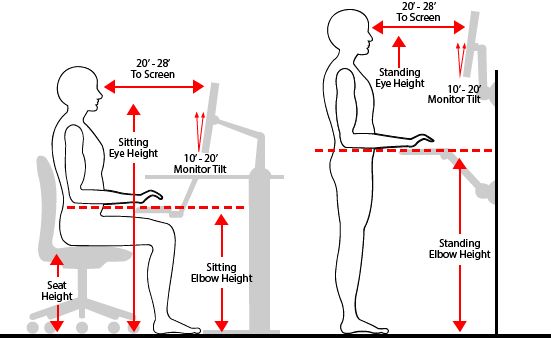How a Height Adjustable Table Can Improve Your Posture and Reduce Back Pain
In today's fast-paced world, most of us spend a considerable amount of time sitting at a desk, whether it's at work or at home. Sitting for extended periods can lead to various health problems, including back pain, neck pain, and poor posture. Fortunately, the height adjustable table is a solution that can help alleviate these issues. In this blog, we'll explore how a height adjustable table can improve your posture and reduce back pain.
What is a Height Adjustable Table?
A height adjustable table, also known as a standing desk, is a desk that can be adjusted to various heights, allowing the user to stand or sit while working. The table's height can be adjusted manually or through an electric motor. Height-adjustable tables come in various sizes, shapes, and designs, making them suitable for any workspace.
How a Height Adjustable Table Can Improve Your Posture:
Good posture is essential to overall health and well-being. Poor posture can lead to various problems such as back pain, neck pain, headaches, and even breathing difficulties. A height adjustable table can help improve your posture in the following ways:
- Allows for Movement: One of the main benefits of a height adjustable table is that it allows you to move freely between sitting and standing positions. This movement helps prevent the stiffness and muscle tension that can come with prolonged sitting.
- Encourages Active Sitting: Height adjustable tables can also encourage active sitting, which involves engaging your core and back muscles while seated. By adjusting the table's height to a standing position, you can promote better posture by standing up straight and engaging your core muscles.
- Reduces Neck and Shoulder Strain: Sitting in the same position for long periods can cause strain on your neck and shoulder muscles. With a height-adjustable table, you can adjust the height of your workspace to a comfortable level that reduces strain on these muscles.
- Improves Blood Flow: Standing while working at a height adjustable table can improve blood flow throughout your body. Improved circulation can help reduce muscle tension and improve overall posture.
How a Height Adjustable Table Can Reduce Back Pain:
Back pain is a common complaint among those who spend extended periods sitting at a desk. The following are some ways a height-adjustable table can help reduce back pain:
- Provides Relief from Compression: Prolonged sitting can lead to spinal compression, which can cause back pain. A height-adjustable table allows you to stand up and take pressure off your spine, providing relief from compression.
- Promotes Active Sitting: As mentioned earlier, a height-adjustable table can promote active sitting. Engaging your core and back muscles while seated can help strengthen these muscles and reduce the likelihood of back pain.
- Offers Flexibility: A height adjustable table provides flexibility in your workspace, allowing you to adjust the table's height to a level that is comfortable for your back. This adjustability can help relieve tension and pressure on your back muscles.
- Encourages Movement: Regular movement is crucial to preventing and reducing back pain. A height adjustable table allows you to switch between sitting and standing positions, promoting movement and reducing the likelihood of stiffness and muscle tension.
- Correct Ergonomics: The height adjustable table provides the ability to customize the desk's height and position to fit the user's body, resulting in improved ergonomics. Poor ergonomics can cause strain on the back, neck, and shoulders, leading to pain and discomfort. By adjusting the table's height to the correct position, users can ensure that their body is in alignment and reduce the likelihood of pain and discomfort.
- Improved Energy and Productivity: Prolonged sitting can cause fatigue and reduced energy levels, leading to decreased productivity. By incorporating movement into the workday, users can improve their energy levels and productivity. A height adjustable table provides the opportunity to stand and move, promoting better blood flow and reducing fatigue.
- Mental Health Benefits: There is evidence to suggest that standing and moving throughout the day can have a positive impact on mental health. Exercise releases endorphins, which can improve mood and reduce stress. Incorporating standing and movement into the workday can have a positive impact on mental health and well-being.
- Adjusting the Height: The height of the table should be adjusted to the user's needs. When standing, the elbows should be at a 90-degree angle, and the wrists should be straight. The monitor should be at eye level, and the user should be able to stand comfortably for an extended period. When sitting, the desk should be at a height that allows the user to sit with their feet flat on the ground, and the arms should be at a 90-degree angle.
- Gradual Adjustment: When incorporating a height adjustable table into the workday, it is recommended to gradually increase the standing time. Starting with 15-20 minutes and gradually increasing the time can allow the body to adjust to the change. Standing for extended periods can cause fatigue and discomfort, so it is essential to listen to the body's needs and adjust accordingly.
- Supporting Accessories: In addition to a height adjustable table, there are several accessories that can support good posture and reduce back pain. An ergonomic chair, footrest, and anti-fatigue mat can all provide additional support and comfort.
Conclusion:
In conclusion, a height adjustable table is an excellent investment for anyone who spends extended periods sitting at a desk. By promoting good posture and reducing back pain, a height adjustable table can help improve your overall health and well-being. If you're considering purchasing a height adjustable table, consider your workspace needs and choose a design that best fits your needs. Remember to take regular breaks and move throughout the day, regardless of whether you're sitting or standing at your desk.

.jpeg)


Comments
Post a Comment